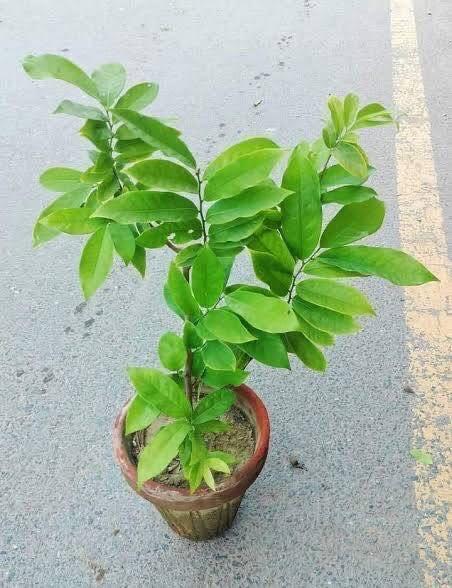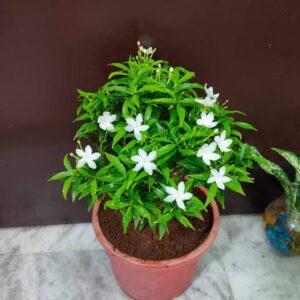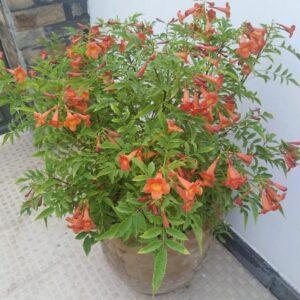Atro Batro PlantThe Climbing Perfume Vine, also known as the Atro Batro Plant (Artabotrys hexapetalus), is a species of climbing vine.
A tropical woody climber cultivated for its very fragrant, yellow-green blooms and glossy green foliage, Artabotrys hexapetalus, sometimes known as Atro Batro, is widely used. This species, which is native to Southeast Asia, is commonly seen in Indian gardens, where it is referred to by local names like Manorangini, Garlic Vine, or simply Ylang Ylang Climber.
Artabotrys, unlike its cousin the tree ylang-ylang (Cananga odorata), is a shrubby vine that may be trained on trellises, fences, or pergolas. It may ascend with the aid of its hooked branches without needing support ties.
🌸 Overview
Artabotrys hexapetalus is the botanical name.
Popular names: Climbing Ylang-Ylang, Manorangini, Ilang-ilang de Chine, Atro Batro
Plant type: Scrambling shrub or evergreen woody climber
6 to 15 feet in height (can grow taller when trained)
Glossy, ovate green leaves make up the foliage.
Flowers: Star-shaped, ranging from pale yellow to greenish-yellow; intensely scented
Fragrance: Potent and sugary, particularly in the mornings and evenings
The bloom season is from spring to late summer, although in certain warm climates it might continue all year round.
Temperature and Light Needs
Sunshine:
Grows well in full sun to somewhat shaded areas
For optimal flowering, it needs 4–6 hours of direct sunlight every day.
Temperature:
Optimal range: 20–35°C (68–95°F)
Susceptible to frost; in colder regions, cultivate in containers or protect.
Appropriate for tropical and subtropical regions
🌞 Excessive shade can result in leggy development and fewer flowers.
💧 Watering Schedule
Young plants:
For the first year, water two or three times a week to encourage root development.
Mature plants:
Water once or twice a week in hot, dry conditions
Lower the frequency to once a week or as necessary during the monsoon or winter.
💧 Important advice: The ground should be damp, but not saturated. Make sure there’s good drainage to avoid root rot.
🌱 Soil and Fertilizer Requirements
Soil:
Favors rich, well-draining loam or sandy soil.
pH range: between 6.0 and 7.5 (slightly acidic to neutral)
Add compost, cocopeat, or organic material to the soil to make it better.
Fertilizer:
Once a month throughout the growth season, use balanced NPK fertilizer (10-10-10) to feed.
Use phosphorus-rich fertilizers, such bone meal or bloom boosters, to increase blooming.
Vermicompost, banana peel tea, fish emulsion, and other organic supplements are effective.
💡 Don’t use too much fertilizer since it might encourage leafy development at the expense of blossoms.
Maintaining and Pruning
When to prune: Late winter or following flowering washes
What needs to be pruned:
Get rid of any branches that are dead, broken, or overcrowded.
Mold the plant to promote a bushier appearance and additional flower buds
Light pruning after each bloom cycle can promote repeated blooming.
Advice for training: For upward growth, use a trellis or wire frame. The plant has a natural propensity for attaching to supports.
🌿 Techniques for Propagation
Half-Hardwood Cutting:
In the spring or early summer, cut 6–8 inch pieces.
lowering rooting hormone levels
Plant in cocopeat or damp, sandy soil.
Under hot, humid conditions, roots grow in four to six weeks.
Layering of Air:
A trustworthy technique for mature branches
Wrap a wounded stem section with plastic wrap and damp moss until roots appear.
🌱 Although seed propagation is feasible, it is sluggish and not frequently employed.
🐛 Issues and Pests
Usually immune to pests, but sometimes susceptible to:
whiteflies or aphids
Scale insects on older stems
Powdery mildew in crowded or moist environments
Apply neem oil spray or insecticidal soap as treatment.
Avoid watering overhead and make sure there is adequate airflow.
Applications for the garden
Ideal for use as a fragrant climber for:
Pergolas
Treillage
Arches
Fences
Suitable for temple gardens, balcony containers, or courtyard gardens
Enhances patios and pathways with nighttime scents.
🌿 For a very fragrant environment, try pairing it with jasmine, plumeria, or rangoon creeper.
⚠️ Additional Information
safe for animals and people
In traditional perfumery, flowers and leaves are sometimes employed.
Appropriate for container gardening with support systems
✅ Conclusion
The Atro Batro (Artabotrys hexapetalus) is a lovely, aromatic vine that adds a hint of tropical sophistication to any yard or patio. It rewards gardeners with waves of fragrant flowers if given moderate care, sunshine, and well-draining soil. Ideal for perfume enthusiasts, its graceful foliage and climbing behavior also provide aesthetic appeal.”
Atro Batro Plant (Artabotrys hexapetalus )
₨2,000.00
“The exquisite flowering vine known as **Atro Batro** (*Artabotrys hexapetalus*), also known as **Climbing Ylang-Ylang**, **Manorangini**, or **Har Singar**, is native to Southeast Asia. Its distinctive, greenish-yellow blooms, which produce a powerful, sweet fragrance, particularly in the evenings, are well-known. Its six slender, waxy petals are what give it the name *hexapetalus*.
This partially woody climber can be trained to grow on trellises, fences, or arches and flourishes in warm conditions. Well-drained, nutrient-rich soil and complete sunshine are its favorites. Frequent pruning and regular watering promote improved growth and blooming. In addition to its aesthetic value, Atro Batro is also valued for its fragrant blossoms, which are frequently employed in traditional garlands and scents. Ideal for vertical landscaping and gardens with fragrant flowers.”




Reviews
There are no reviews yet.